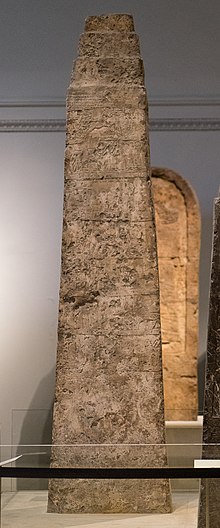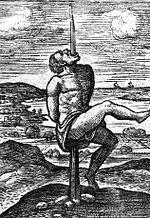the Neo-Assyrian Empire from 883 to 859 BCE. Ashurnasirpal II succeeded his father, Tukulti-Ninurta II. His son and successor was Shalmaneser III and...
24 KB (2,688 words) - 19:47, 12 September 2024
The Stela of Ashurnasirpal II is an enormous Assyrian monolith that was erected during the reign of Ashurnasirpal II. The stela was discovered in the...
3 KB (323 words) - 20:26, 11 October 2023
The Statue of Ashurnasirpal II is a rare example of Assyrian sculpture in the round that was found in the mid nineteenth century at the ancient site of...
4 KB (402 words) - 01:45, 11 April 2021
Šalmanu-ašaredu II, who mentions him in one of his own inscriptions and later by another son, the long-reigning Aššur-rabi II. White Obelisk of Ashurnasirpal I Khorsabad...
5 KB (519 words) - 08:34, 17 November 2023
king Ashurnasirpal II provide more details about him and his reign than are known for any other ruler of this epoch. The palaces of Ashurnasirpal II, Shalmaneser...
56 KB (6,696 words) - 05:31, 29 August 2024
was a queen of the Neo-Assyrian Empire as the primary consort of Ashurnasirpal II (r. 883–859 BC). She was probably also the mother of his son and successor...
11 KB (1,385 words) - 06:54, 25 April 2024
Neo-Assyrian Empire (section Sargon II and Sennacherib)
Under Ashurnasirpal II (r. 883–859 BC), Assyria once more became the dominant power of the Near East, ruling the north undisputed. Ashurnasirpal's campaigns...
194 KB (24,930 words) - 20:55, 17 September 2024
The Neo-Assyrian Empire arose in the 10th century BC. Ashurnasirpal II is credited for utilizing sound strategy in his wars of conquest. While aiming to...
51 KB (6,751 words) - 16:26, 27 July 2024
decorated the gardens with scenes of his military achievements. His son, Ashurnasirpal II, succeeded him. Chen, Fei (2020). Study on the Synchronistic King List...
4 KB (307 words) - 00:46, 8 January 2024
Ashurnasirpal may refer to: Ashurnasirpal I, king of Assyria from 1050 to 1031 BCE Ashurnasirpal II, king of Assyria from 884 to 859 BCE This disambiguation...
164 bytes (56 words) - 18:05, 27 December 2019
overt sadism (unlike the inscriptions of some other kings, such as Ashurnasirpal II). Atrocities enacted by Assyrian kings were in most known cases directed...
88 KB (11,410 words) - 08:02, 15 September 2024
beloved by the Assyrians as a formidable warrior. The Assyrian king Ashurnasirpal II (ruled 883–859 BC) built a massive temple for him at Kalhu, which became...
40 KB (4,187 words) - 13:35, 18 September 2024
White Obelisk (redirect from White Obelisk of Ashurnasirpal I)
variously ascribed to the reigns of Ashurnasirpal I (c. 1040 BC), Tiglath-Pileser II (c. 950 BC) or Ashurnasirpal II (c. 870 BC). The obelisk was discovered...
5 KB (536 words) - 22:18, 3 August 2024
Ashurnasirpal II (r. 883–859 BC), the Neo-Assyrian Empire became the dominant political power in the Near East. In his ninth campaign, Ashurnasirpal II...
140 KB (17,052 words) - 12:32, 19 July 2024
of c. 852 BC & 879 BC that contain a description of the reigns of Ashurnasirpal II and his son Shalmaneser III. The Monoliths were discovered in 1861...
32 KB (4,337 words) - 06:39, 3 July 2024
pre-eminent") was king of the Neo-Assyrian Empire from the death of his father Ashurnasirpal II in 859 BC to his own death in 824 BC. His long reign was a constant...
15 KB (1,584 words) - 00:29, 16 April 2024
Key (male • female • KING) ADAD-NIRARI II (r. 911-891 BC) TUKULTI-NINURTA II (r. 890-884 BC) ASHURNASIRPAL II (r. 883-859 BC), m. Mullissu-mukannishat-Ninua...
101 KB (12,899 words) - 18:27, 31 August 2024
Nebuchadnezzar II (/nɛbjʊkədˈnɛzər/; Babylonian cuneiform: Nabû-kudurri-uṣur, meaning "Nabu, watch over my heir"; Biblical Hebrew: נְבוּכַדְנֶאצַּר Nəḇūḵaḏneʾṣṣar)...
91 KB (11,125 words) - 01:17, 7 September 2024
as proofs of their might that they took pride in. Neo-Assyrian King Ashurnasirpal II (r. 883–859 BC) was evidently proud enough of his bloody work that...
91 KB (9,897 words) - 21:50, 20 May 2024
of large halls. The style apparently began after about 879 BC, when Ashurnasirpal II moved the capital to Nimrud, near modern Mosul in northern Iraq. Thereafter...
38 KB (5,147 words) - 16:01, 17 December 2023
buildings at Balawat (ancient Imgur-Enlil), dating to the reigns of Ashurnasirpal II (r. 883–859 BC) and Shalmaneser III (r. 859–824 BC). Their extensive...
13 KB (1,650 words) - 12:32, 15 July 2024
The obelisk was erected by either Ashurnasirpal I (1050–1031 BCE) or Ashurnasirpal II (883–859 BCE). The obelisk bears an inscription that refers to the...
35 KB (4,173 words) - 08:02, 17 August 2024
huntsmen close beside the king use their spears. An earlier king, Ashurnasirpal II (r. 883-859), who had erected other lion hunt reliefs in his palace...
14 KB (1,725 words) - 23:50, 4 September 2024
Queens' tombs at Nimrud (section Tomb II)
Son of adad-nirari [II] King of the World, King of the land of ashur.” Ashurnasirpal certainly refers to king Ashurnasirpal II, who constructed the palace...
35 KB (4,916 words) - 05:33, 31 August 2024
most notable places where the genies existed were Ashurnasirpal II’s palace Kalhu and Sargon II’s palace Dur-Sharrukin. They appear in the reliefs of...
8 KB (956 words) - 14:55, 9 September 2023
1845 and 1851. At Nimrud, Layard discovered the North-West Palace of Ashurnasirpal II, as well as three other palaces and various temples. He later uncovered...
228 KB (24,835 words) - 20:18, 5 September 2024
as their king while others pick Tibni. 883 BC—Ashurnasirpal II succeeds his father Tukulti-Ninurta II as king of Assyria. 881 BC—Tibni the son of Ginath...
1 KB (168 words) - 01:12, 6 July 2024
Ada; Kangas, Steven E. (2010). Assyrian Reliefs from the Palace of Ashurnasirpal II: A Cultural Biography. UPNE. p. 127. ISBN 978-1-58465-817-7. Bible...
15 KB (1,678 words) - 04:52, 1 September 2024
List of Assyrian kings (redirect from Sharma-Adad II)
the time of Ashurnasirpal I (r. 1049–1031 BC). The oldest of the surviving king-lists, List A (8th century BC) stops at Tiglath-Pileser II (r. 967–935...
87 KB (7,441 words) - 19:39, 20 July 2024
to the throne. 884 BC: Ashurnasirpal II succeeds his father Tukulti-Ninurta II as king of Assyria. ~880 BC: Ashurnasirpal II moves the Assyrian capital...
8 KB (953 words) - 19:24, 19 August 2024

























